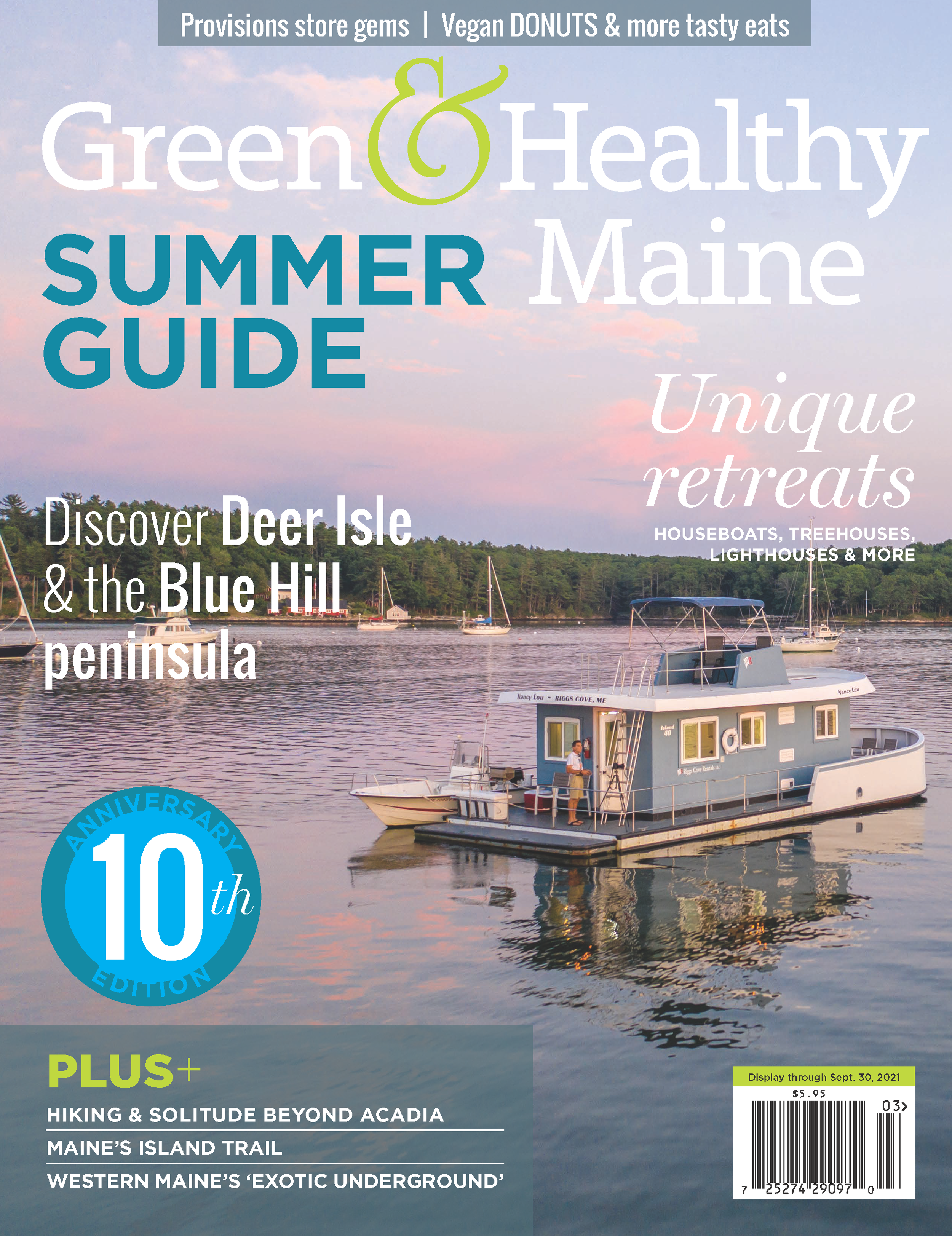Tourmaline turns 200
Newry Watermelon Tourmaline Slice. Photo: J.Scovil.
Western Maine’s “exotic underground” celebrated at the Maine Mineral and Gem Museum
By Caitlin Gilmet
On a fall afternoon in 1821, students Elijah Hamlin and Ezekiel Holmes were prospecting for minerals on Mount Mica, near Paris, Maine. As Elijah paused to take in the sunset, he noticed a glimmer of green near the roots of a tree. The students pried a sparkling crystal from the dirt as the sun descended, and they planned to return the next morning to look for more treasure.
Overnight, snow covered Western Maine, and the young men were forced to wait until spring to see what else the rock ledge might reveal. When they finally climbed back to the source of their initial discovery, they found dozens of brilliant crystals dotting the landscape. The site became popular with amateur treasure-seekers, and analysis by a professor at Yale University determined that the crystals were called tourmaline.
Over time, the mountains of Western Maine have revealed some of the world’s finest and largest specimens of tourmaline, including a flawless 256-carat gem the color of the Caribbean Sea and a 69-carat gem purchased by Tiffany & Co. Just one year after Maine joined the Union as a free state, the treasure trove of tourmaline found here made national news.
Tourmaline crystals are produced in pegmatites, cavities deep underground in igneous and metamorphic rocks formed by molten magma from volcanoes. Hydrothermal activity releases hot water and vapor with trace mineral elements, which settle in fissures and begin to grow. All tourmaline is made up of aluminum boron silicate, and it may contain iron, potassium, manganese, lithium or sodium, which give the stones a wider range of colors than any other gemstone.
The ancient Egyptians believed that tourmaline gemstones got their vibrant colors because they broke through rainbows as they pushed through the earth. These semiprecious stones have been discovered in California, Sri Lanka, China and Russia, but Maine remains a principal source of the gem.
Exterior of Maine Mineral and Gem Museum on Opening Day, in late 2019. Photo courtesy of Maine Mineral and Gem Museum.
Two centuries after tourmaline’s discovery in Maine, our official state mineral and gem is being celebrated with an exhibit at the Maine Mineral and Gem Museum (MMGM) on Main Street in Bethel.
Space Rocks Gallery, showcasing the Stifler Collection of Meteorites. Photo courtesy of Maine Mineral and Gem Museum.
The MMGM opened to the public in April—for the second time, after an interior flood and then the pandemic thwarted a 2019 opening. The 15,000-square-foot, three-floor museum was founded by husband-and-wife team Larry Stifler and Mary McFadden and born out of a 15,000-acre land trust that includes the Bumpus Mine, a leading source of gem tourmaline.
“We have this hyper local geologic history right under our feet—this exotic underground that holds these gems,” says Communications Director Jo Sorrell. “Tourmaline is an extraordinary gem, and the exhibit highlights both its geologic and human history through interactive displays, oral histories and gem jewelry.”
Visitors can also see more than 40,000 gems and minerals, 6,000 meteorites, fossils, artifacts and, of course, tourmaline jewelry.
“I hope people come away with a sense of wonder about how this place on the planet formed,” Sorrell says. “And the museum is steeped in the history of mining and educating about mining.”
MMGM also houses a library and research lab, which are central to the Museum’s mission of advancing knowledge through pioneering research on minerals, rocks and meteorites. Leading these efforts is Dr. William “Skip” Simmons, emeritus professor of minerology at the University of New Orleans. “The Museum is right in the heart of pegmatite country,” he says, “providing an incredible environment for mineralogic research.”
Mt. Marie Elbaite with Purple Fluorapatite. Photo: J. Scovil.
One goal of the MMGM Research Laboratory is to help people understand their gemstones and where they came from through a new, nondestructive chemical process. “We’re working to be able to understand the precise location of where certain Maine tourmalines were formed,” Simmons says. “We do this by using instrumentation that enables us to see the chemical makeup of certain tourmalines. In essence, we’re developing chemical ‘fingerprints’ to characterize the tourmalines from the deposits where they formed, and from where they were eventually unearthed.”
MMGM’s tourmaline collaborations involve art as much as they do science. MMGM supplies tourmaline for artists who create jewelry sold in the Museum store at a fair commission.
“We give them stones that work with their aesthetic and perspective,” says Maggie Kroenke, who manages the Museum Store. “A lot of artists love to work with tourmaline because it’s not a soft or especially breakable stone, and it comes in every color and hue of the rainbow. It’s versatile and fun to work with.”
And buyers love that their stones can be traced to an exact location.
“They know the story behind their gem, and that makes it one of a kind,” Kroenke says. “We get requests for engagement rings and other custom pieces, because tourmaline is a symbol of Maine’s beauty. It’s a source of pride and a little piece of home.”






